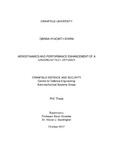JavaScript is disabled for your browser. Some features of this site may not work without it.
| dc.contributor.advisor | Knowles, Kevin | |
| dc.contributor.advisor | Saddington, A. J. | |
| dc.contributor.author | Ehirim, O H | |
| dc.date.accessioned | 2018-05-21T15:54:58Z | |
| dc.date.available | 2018-05-21T15:54:58Z | |
| dc.date.issued | 2018-04 | |
| dc.identifier.uri | http://dspace.lib.cranfield.ac.uk/handle/1826/13211 | |
| dc.description.abstract | This study involved experimental and equivalent computational investigations into the automobile-type 3―D flow physics of a diffuser bluff body in ground-effect and novel passive flow-control methods applied to the diffuser flow to enhance the diffuser’s aerodynamic performance. The bluff body used in this study is an Ahmed-like body employed in an inverted position with the slanted section together with the addition of side plates along both sides forming the ramped diffuser section. The first part of the study confirmed reported observations from previous studies that the downforce generated by the diffuser in proximity to a ground plane is influenced by the peak suction at the diffuser inlet and subsequent static pressure-recovery towards the diffuser exit. Also, when the bluff body ride height is gradually reduced from high to low, the diffuser flow as indicated by its force curve and surface flow features undergoes four distinct flow regimes (types A to D). The types A and B regimes are reasonably symmetrical, made up of two low-pressure core longitudinal vortices travelling along both sides of the diffuser length and they increase downforce and drag with reducing ride height. However, below the ride heights of the type B regime, types C and D regimes are asymmetrical because of the breakdown of one vortex; consequently a significant loss in downforce and drag occurs. The second part of the study involved the use ― near the diffuser exit ― of a convex bump on the diffuser ramp surface and an inverted wing between the diffuser side plates as passive flow control devices. The modification of the diffuser geometry with these devices employed individually or in combination, induced a second-stage pressure-drop and recovery near the diffuser exit. This behaviour was due to the radial pressure gradient induced on the diffuser flow by the suction surface ii curvature of the passive devices. As a result of this aerodynamic phenomenon, the diffuser generated across the flow regimes additional downforce, and a marginal increase in drag due to the profile drag induced by the devices. | en_UK |
| dc.language.iso | en | en_UK |
| dc.rights | © Cranfield University, 2015. All rights reserved. No part of this publication may be reproduced without the written permission of the copyright holder. | |
| dc.subject | Ground-effect | en_UK |
| dc.subject | Aerodynamics | en_UK |
| dc.subject | Diffuser | en_UK |
| dc.subject | Passive flow control | en_UK |
| dc.subject | Inverted wing | en_UK |
| dc.subject | Convex bump | en_UK |
| dc.subject | Downforce | en_UK |
| dc.subject | Drag | en_UK |
| dc.title | Aerodynamics and performance enhancement of a ground-effect diffuser | en_UK |
| dc.type | Thesis | en_UK |
